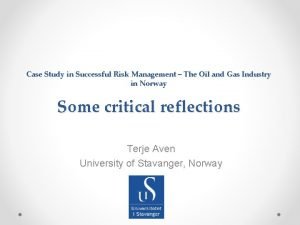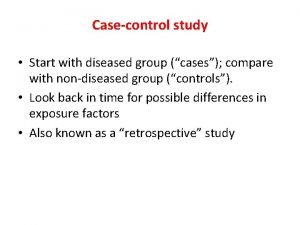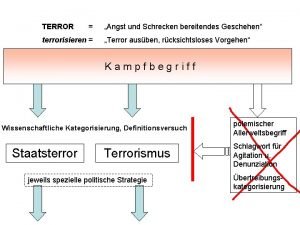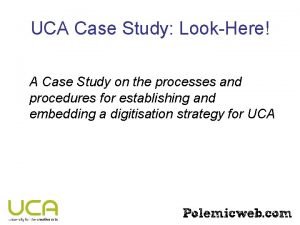ADA AND TERROR ADA and Terror Case Study























- Slides: 23

+ADA AND TERROR

ADA and Terror Case Study + Prior to September 11 th, Sam’s essential job functions included frequently meeting with clients in cities across America, sometimes visiting two or three cities per week. Given the distances involved, flying has always been the only practical way to accomplish this. Sam seeks psychological treatment following the attacks and provides his employer with a medical note stating he is suffering from posttraumatic stress disorder.

ADA and Terror Case Study + Sam, with his psychologist’s support, requests the following accommodations: + (i) “temporary” elimination of travel requiring flying + (ii) the use of software that allows internet-based video meetings through which he believes he can effectively communicate with his clients

ADA and Terror Case Study + Is Sam a qualified individual with a disability (“QIWD”) ? + or in other words + Is Sam an individual with a physical or mental impairment who, with or without reasonable accommodation, can perform the essential functions of the employment position he holds?

ADA and Terror Case Study + Is Sam a qualified individual with a disability? Evaluate #1: Whether Sam has a protected impairment Evaluate #2: If so, whether flying is an essential function of his job Evaluate #3: If so, whether a reasonable accommodation exists that would allow Sam to perform the essential functions of his job

ADA and Terror Case Study + + Question #1: Does Sam Have A Protected Disability?

Post Traumatic Stress Disorder Defined + Exposure to a traumatic event in which the following is experienced or witnessed: + Actual or threatened death or serious injury; or + A threat to the physical integrity of oneself or others; and + Feeling intense fear, helplessness or horror.

Post Traumatic Stress Disorder Defined + The traumatic event is persistently reexperienced (e. g. , recollections, dreams); + The stimuli associated with the trauma are avoided; + Persistent symptoms are experienced, such as difficulty sleeping, angry outbursts, difficulty concentrating, or hypervigilance.

ADA and Terror Case Study + Question #2: + Is Flying an Essential Function of Sam’s Job?

Flying As Essential Function? + Air Travel Was An Essential Function Of The Job For An Auditor Of Universities In 10 States Because Effective Auditing Required Access To Records And Employees For Interviews At Audited Sites. + Wells v. Shalala (10 th Cir. 2000)

Flying As Essential Function? + Flying Is An Essential Function For A Vice President Of Sales Required To Frequently Fly To Visit Customers. + Connolly v. Bidermann Industries (SDNY 1999)

Flying As Essential Function? + Consider the following: + Written Job Description + Current Work Experience of Other Incumbents + Consequences of Not Flying

ADA and Terror Case Study + Question #3: + + Does A Reasonable Accommodation Exist That Will Enable Sam To Perform The Essential Functions of His Job?

Does Reasonable Accommodation Exist? + Q. Will Internet-Based Video Meetings Enable Sam To Perform His Essential Functions? A. Depends on purpose of client meetings, prior history, etc.

ADA and Terror - Reasonable Accommodation? + A. Q. Can the Company Require Sam to Travel By Train, Rather Than Fly, In Lieu of the Accommodation He Requested? Probably, if travel by train will enable Sam to perform the essential functions of his job meeting with his client on a timely basis.

Work at Home Case Study + Assume Sam is not required to fly for his job, but is afraid to return to work at his job on the 45 th floor of the Empire State Building. In fact, he refuses to work above the second floor of any building and instead requests to work from his home. If Sam has a protected disability, must his employer accommodate this request?

Work At Home + EEOC: Employer Must Allow As Reasonable Accommodation Unless It Would Not Be Effective and Would Impose Undue Hardship. Considerations Include: +Ability to Supervise Employee Adequately +Need for Personal Contact +Need for Interaction or Coordination +Employee’s Need To Work With Certain Equipment or Tools Unavailable At Home

Work At Home + Courts Generally Disfavor “Home Work” As A Reasonable Accommodation + Claims Adjuster’s Duties As Advisor to Call Center Staff Often Require “On-the-Spot Collaborative Efforts” Among Employees, Particularly Due to His High Level of Technical Expertise + Kvorjak v. Maine (1 st Cir. 2001)

Work At Home + Work at Home Is Not A Reasonable Accommodation for Software Systems Designer Where Personal Contact and Coordination with Staff Members, As Well As Working Under Severe Time Restraints, Were Required in Plaintiff’s Line of Work + Misek-Falkoff v. IBM Corp. (2 d Cir. 1995)

Leave of Absence Case Study + As time goes on, Sam finds he is sleeping less than 2 hours every night, he is hardly eating and he can’t concentrate on his work. While he is more productive working at home, he still is barely contributing to his team. Sam advises his employer that, based on his psychiatrist’s diagnosis, he is totally disabled and cannot work, for now, even from home. He requests an indefinite leave of absence. Sam’s doctor certifies that Sam is disabled but cannot provide any indication of how long Sam will need to be out on leave. Must Sam’s employer accommodate his request for a leave of absence or can it terminate his employment?

Leave of Absence +Leave of Absence Is Generally Reasonable Accommodation +In Contrast, Unpredictable Leave Resulting in Erratic Attendance Is Not Reasonable

Leave of Absence !Request for indefinite leave is: + EEOC — Reasonable Absent Undue Hardship + Courts — Generally Unreasonable Especially Where Employee Has Previously Been Provided Substantial Leave

Leave of Absence + Open-ended Leave Request By Plaintiff Due To Panic Attacks And Fear of Stress Was Not A Reasonable Accommodation + “An Employer Is Not Required To Wait Indefinitely For. . . [the Disabled Employee’s] Recovery. ” + Smith v. Blue Cross Blue Shield, Inc. (10 th Cir. 1996)
 Best case worst case average case
Best case worst case average case Fbi virtual case file case study
Fbi virtual case file case study Gaya ada yang dan ada pula yang
Gaya ada yang dan ada pula yang Dalam laporan percobaan tidak ada urutan waktu tetapi ada
Dalam laporan percobaan tidak ada urutan waktu tetapi ada Negasi dari jika ada gula maka ada semut adalah
Negasi dari jika ada gula maka ada semut adalah Verna and sam case study
Verna and sam case study Long case vs short case
Long case vs short case Binary search performance
Binary search performance Bubble sort best case and worst case
Bubble sort best case and worst case Bubble sort best case and worst case
Bubble sort best case and worst case Bubble sort best case and worst case
Bubble sort best case and worst case Ambiguous cases law of sines
Ambiguous cases law of sines Plant and machinery valuation project report
Plant and machinery valuation project report Phenomenology vs case study
Phenomenology vs case study Case study on deforestation in andaman and nicobar islands
Case study on deforestation in andaman and nicobar islands Risk management case study oil and gas industry
Risk management case study oil and gas industry Amazon and whole foods merger case study
Amazon and whole foods merger case study Syngenta sharepoint
Syngenta sharepoint Raleigh and rosse real company
Raleigh and rosse real company Kekurangan metode studi kasus
Kekurangan metode studi kasus Chapter 5 life after high school
Chapter 5 life after high school Moral dimensions of information systems
Moral dimensions of information systems Difference between case control and cohort study
Difference between case control and cohort study Case control study example
Case control study example













































